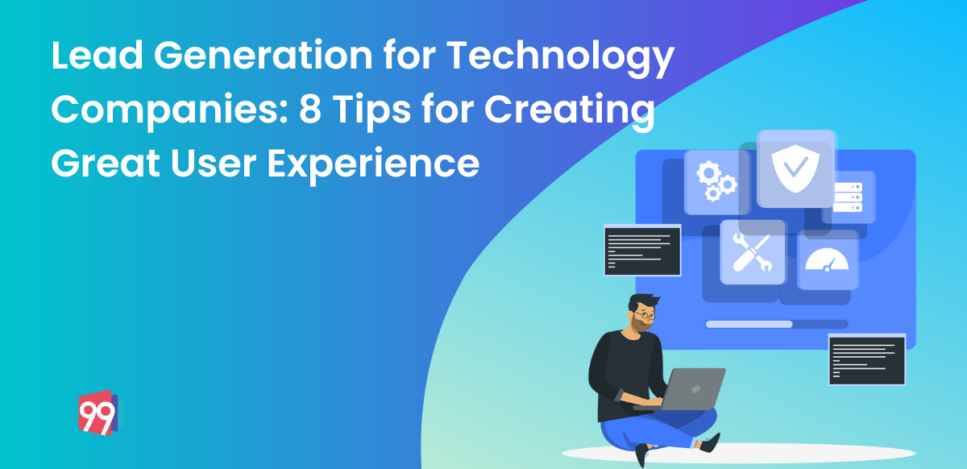When done right, lead generation for technology companies fetches a lot of traction and conversions. As the competition in the tech industry keeps rising, it becomes crucial for tech businesses, be it consultants or SaaS, to up their game. The end goal of lead generation is the same for every industry: conversions. But the buyers’ journeys change according to the target audience and market demands.
Creating lead generation strategies focusing on prospect conversion and customer retention is crucial as consumers have many options. Technology businesses might lose clients to competitors with no clear lead generation workflow.
Lead generation for technology companies should utilise marketing tactics that send a clear brand message and attracts high intent prospect, not just ‘interested’ prospects. In this blog, we will discuss seven lead generation tips designed for technology businesses to help them attract a steady flow of quality leads.
How is Lead Generation for Technology Companies Different from Retail?
Lead generation is a process built by keeping the target audience in mind. While retail mainly relies on individual buyers, SaaS and tech companies sell to individuals and other businesses. When it comes to attracting audiences, retail companies take the route of emails, phone calls, direct mailings, etc. Most of the e-commerce and retail products are one-time purchases followed up by cross-sell and upsell offers.
Generating leads for technology companies is typically more intricate and time-consuming than retail lead generation. Tech businesses search for prospects with specific problems that can be solved through their services. Technology marketers search for such leads through social media sites (LinkedIn, Twitter), search engines (Google), and other online sources. Additionally, technology lead generation often requires different strategies than retail lead generation when targeting potential customers. For example, while display ads work well for retail, tech businesses use PPC adverts to gain traction and leads.
Inbound marketing sales funnel is an excellent strategy for technology companies to follow for lead generation. It has four stages:
- Awareness: It is when potential customers become aware of the technology and starts exploring the brand.
- Consideration: It occurs when the potential customer starts to learn more about the technology and what it can do for them.
- Decision: At this stage, conversion occurs when the customer takes action on their interest in the technology and makes a purchase.
- Retention: Here, customer relationships get nurtured to drive repeat business and encourage word-of-mouth marketing.
Tips on Lead Generation for Technology Companies
1. Build Impactful Landing Pages
Landing pages are critical for technology companies as they seek to generate leads and drive conversions. They are also essential to creating an online presence that is engaging and persuasive, attracting new customers and building brand awareness.
There are many factors to consider when designing landing pages, including the company’s target audience, the overall marketing strategy, and the specific product or service offered. However, one key factor that marketers cannot ignore is lead generation. Landing pages must be designed with lead generation in mind to produce results.
There are many effective methods for generating leads on landing pages, including email capture forms and pop-ups. Email capture forms allow visitors to enter their contact information in order to receive future notifications about relevant products or services. Pop-ups can be especially effective as they prompt visitors to take action (such as signing up for a mailing list) without disrupting their browsing experience.
For example, MemberMeister, management software for online users, uses a landing page to generate leads. It has a single-form field and a straightforward copy supported by social proof.

2. Know Your Target Audience
As a technology company, it’s essential to know your target audience. It means understanding who you want to reach and what they want from your product or service. Once you have a good idea of who your customer is, you can start thinking about the best ways and channels to reach them.
First, it’s essential to think about your audience’s demographics. Who are they? What do they look like? What else do you need to know about them to market effectively to them?
Next, think about their interests. What topics are they passionate about? What sort of content would be most engaging for them? How can you provide that content in an easily consumable format?
Once you have a good idea of who your customer is and what they want, it’s time to start marketing to them in the most effective way possible. Use targeted advertising and content marketing strategies that reflect the interests of your target audience. Letting your customers know who you are and what you offer will help bring them into contact with the products and services that are best suited for them.
3. Provide Free Trials
Technology companies often offer potential customers free trials of their products or services. It allows potential customers to try out the product or service before they commit to buying it. A free trial can also help technology companies track customer feedback and determine whether someone is likely to be a long-term customer.
A free trial can be of many types; some common ones are:
- A free version that has basic features of the services available.
Example: HubSpot

- A free trial version of several days.
Example: ActiveCampaign

Free trials encourage even the least interested prospects to try the services once and create a chance to nurture the lead in a more refined form. It helps increase consumer interactions with the brand and gives potential customers a more precise picture of how the technology solves their problems.
4. Develop a Content Strategy
When it comes to content marketing, there are a few things to keep in mind. First and foremost, you need to develop a strategy. What are your goals for the content? What do you want people to take away from it? Once you have a plan, you need to find the right channels to deliver your message.
There are many different content formats that you can opt to create valuable resources to attract an audience. Some formats are blog posts, social media posts, email campaigns, whitepapers, case studies, etc. The most important thing is to find what works best for your company and stick with it. By following a consistent strategy, you’ll be more likely to achieve your goals and create lasting impressions with your audience.
5. Focus on SEO
When you’re creating your content, be sure to focus on SEO. It means optimising your content for search engines such as Google, Yahoo, and Bing. By doing this, you’ll be able to attract more leads from potential customers looking for information about your products or services.
Whether it’s your blog posts, landing page, website, or paid ads, each needs to get SEOed. To get top rankings in relevant searches, it is crucial to follow good SEO practices on your web page, like:
- Using targeted keywords in the title, descriptions, and throughout the site
- Putting Alt tags on all images
- Optimise web page’s loading speed
- Proper internal linking
6. Organise Webinars
If you are not comfortable with giving out free trials, you should conduct webinars that showcase your services in action. Interested prospects must understand how your technology is relevant to them. With webinars, it becomes easier to interact with consumers in real-time and familiarise them with your technology and brand.
Tech brands must target webinars toward specific groups such as potential customers or employees of technology companies to generate quality leads. Additionally, webinars should include relevant content for potential lead recipients and provide an opportunity to ask questions. Finally, company experts should conduct regular webinars so that potential leads are always up-to-date on the latest trends and establish a trustful bond between the brand and customers.
Technology companies can conduct a mix of webinars ranging from awareness drives about the targeted industry to a 101 session about their services.
7. Showcase Social Proof
When investing in a new technology company, it is vital to consider the company’s credibility behind the product. One way of doing this is through social proof. Social proof can come from various sources, including customer reviews, peer recommendations, and endorsements from industry experts.
Customer reviews are perhaps the most well-known form of social proof. When customers post positive reviews about a product or service, it can give potential investors confidence that the product is good and worth investing in. Peer recommendations can also be powerful tools for technology companies. If a friend or colleague has raved about a particular technology company, it may also be worth considering investing in that company. Endorsements from industry experts can also provide valuable social proof. If a respected technology community member recommends one tech company over another, that may give investors additional confidence in that company’s products and services.
Social proof is essential for technology companies looking to attract investor attention and capital. By demonstrating their products’ and services’ popularity and reliability, tech companies can build trust with potential investors and secure funding for their businesses.
8. Be Ready With a Demo
Don’t wait up for leads to get generated and then turn to make demo presentations and plans. Technology companies must always be ready to take every lead abroad and provide a seamless customer experience. Prepare your demo as if it was the first time someone interacted with your product. It will help ensure a positive customer experience and generate future leads.
Make sure you have a process for collecting and using customer feedback. Tech brands can use such information to improve the product’s design and functionality. By using customer feedback, you’ll be able to create truly valuable services for your target market.
Technology companies must make it easy for customers to become part of their community. If it is easy for customers to join your community and share their opinions, they are more likely to do so. Make sure there is a way for customers to connect and share ideas about your products and services.
Provide useful information about your products and services through blog posts or video article that helps them get set up and customise your tech according to their needs.
Ending Note
Lead generation for technology companies works when you put in the right marketing efforts on the right strategies. Instead of doing a lot, focus on a few strategies highlighting a brand with its USPs. Landing pages, free trials, SEO, webinars, etc., are great ways to capture consumer attention and convert them. By creating an inbound marketing workflow, technology companies can achieve the lead generation goals they have set up.
Other interesting reads:
Organic Lead Generation: 7 Tips to Grow Your Business
Demand Generation vs Lead Generation: What You Need to Know
Lead Generation for Construction Companies: Best Practices To Follow
Featured Templates:
Business Coach Landing Page Template
Boiler Repair Landing Page Template
Home Insurance Landing Page Template





